Text
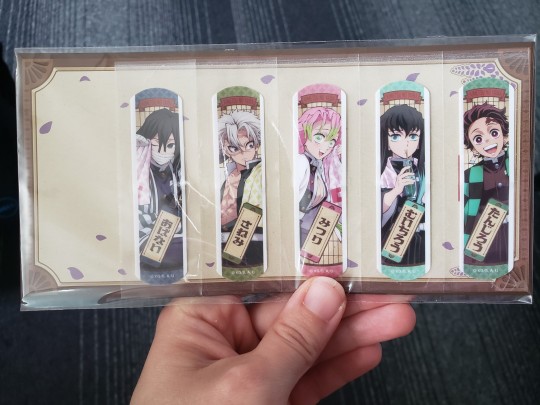
That victorious feeling when you went into the drug store looking for bandages anyway
55 notes
·
View notes
Text
Nerdy cultural details about the word "Hashira"
Some details can be hard to pick up without context or in translation. I recently went over a few details about the Hashira's names, Breaths, or symbols, but today I want to focus on the word "Hashira."
To get this out of the way, I use "Pillar" all over this blog because I thought that's what they were called. I was astounded that phrase was not translated, as it is a (somewhat rare) case of a one-to-one translation equivalent. They are the pillars that support the Demon Slayer Corp, after all. The kanji for it (柱) very literally means "pillar" in any modern day Japanese to English dictionary. But since you all know the word "Hashira," let's climb up and see where it takes us!
First, the kanji itself (brought over from China and given the Japanese pronunciation "hashira," based on the existing spoken Japanese language), is composed of 木 for "tree" and 主 for "master" or "main/principal," among other semi-literal or more widely applicable possible meanings in modern kanji dictionaries. However, Prof. Owada Tetsuo, a retired university professor who published an unofficial book of his own Kimetsu no Yaiba interpretations based on Japanese demon slaying folklore, points out that 主 can also be interpreted as a still flame atop a candlestick, and that 柱 (hashira) is a tree that cannot be moved. (I'll continue to use a lot of Prof. Owada's details in this explanation, as well as details I have picked up in other research.)
That makes 柱 closely associated with holy trees found in, or treated as, Shinto shrines throughout Japan. As Shinto is a nature-based belief system, trees are often something that a kami (deity) will inhabit. Keep Shinto in mind, because we're going to focus on that a lot.
Before that, let's finish up with the kanji 柱. According to the first official fanbook, there is an upper limit of nine Hashira because there are nine strokes in the 柱 kanji. (See this dictionary entry for a breakdown of those nine strokes.)
Now that the easy official tidbit is out of the way, back to the Shinto fun stuff and conjecture! We need to dive a bit more into the spoken Japanese language, from which a lot of Shinto terms derive.
For starters, the Japanese language uses counter words for when you say a certain number of beings or objects. You could think of this as "a sheet of paper" or "three rolls of tape." It is an annoying part of starting out your study of the language because there are a lot to memorize based on sizes, shapes, types of animals, etc. Deities also have their own counter word: 柱 (hashira). This goes to show how the Hashira of the Demon Slayer Corp are something more than human, what with how much power they possess.
Now if we think about the pronunciation of the spoken Japanese word from long before a Chinese written character was assigned to it, the "hashi" of "hashira" is a "bridge." Clever ones among you might know that "hashi" also means "chopsticks." But even chopsticks have the same effect as a bridge! They serve as a connection, bridging the gap between you and what was another living thing, that which will become a part of you as your sustenance. "Hashira," as pillars, are likewise something that serve as a connection, in this case, a vertical one. They are that which connect us with the heavens, or in the case of the Demon Slayer Corp, they bridge the gap between the limits of human strength and the inhuman strength of demons.
As another Shinto tie, one of the connections that Prof. Owada and I both made was that there are nine pillars that support the main sanctuary in shrine architecture like that of Izumo Taisha Grand Shrine. Or rather, in the case of at least one of the historical iterations of Izumo Taisha, there were nine groups of three massive tree trunks each, resulting in a shrine over 48 meters in height (see here for photos of how big the remains of those pillars are and how exciting the archaeology is). These pillars give you a sense of awe for just how powerful pillars can be, especially when you have a spread of nine to distribute the weight.
Now, there's more that Prof. Owada and I would both say about how Izumo Taisha also ties in with the "Ubuyashiki" surname or the "yakata" title by which the Hashira address him, but that's a dose of nerdery for some other time.
#kny nerdery#kny reference#kny references#I forget which tag and I'm sticking it in there for the official fanbook bit#otherwise this is what My Research makes possible#thank you My Research#and thank you Prof. Owada's Research even though I think you're stretching too far to make connections#for the sake of talking about other nerdy folklore stuff in a KnY themed book
68 notes
·
View notes
Text

Kaburamaru learned a very important lesson that day about biting off more than he can chew.
EDIT: Since I wrote this scene into a short fic about these two on a mission together, might as well promote that fic.
#self-reblog because I've been a mood to reblog old art lately#I like my sloppy art but most of it has been sloppy lately#delete later
454 notes
·
View notes
Text
While lounging at home, I have been wearing oni horns from a 100 yen shop. This has been going on for a few months. They suit me oddly well, no matter what my hair is doing or how I'm dressed. They are comfortable.
They feel like a natural part of me, like I was always meant to have oni horns.

I stress again that I have always loved the oni aesthetic, be it silly and oafish or elegantly portrayed in folkloric shoujo manga.
Anyway, I did just walk outside with them because I forgot I had them on.
22 notes
·
View notes
Text

FIC COMPLETED!
"A Chain of Letters" (8,053 words)
Senjurou and Kotetsu become pen pals after Tanjirou suggests they have a lot in common. Their letter exchanges see them through as the world changes around them over the course of the last arcs of the manga.
Sillier, lazier doodles of post-fic friendship behind the cut.




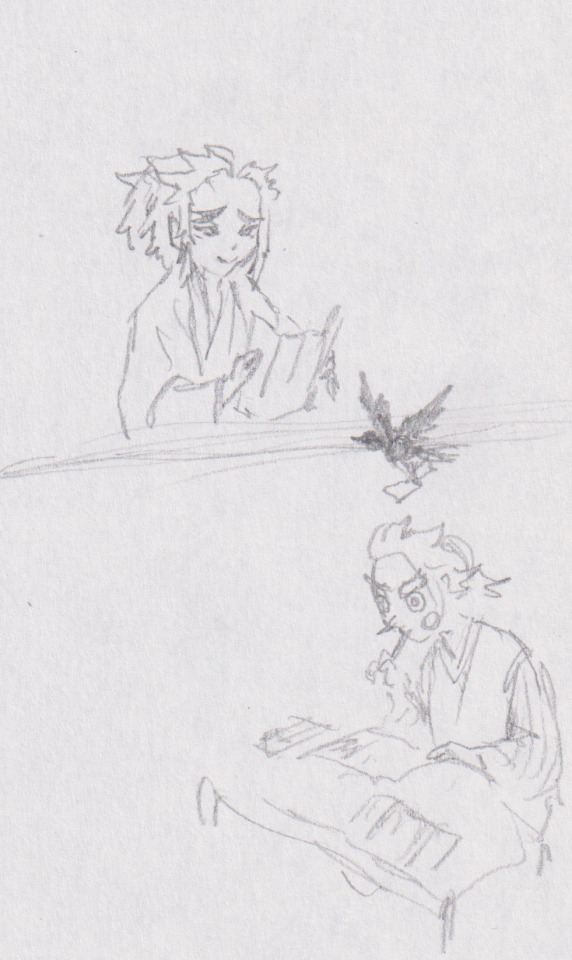
79 notes
·
View notes
Photo
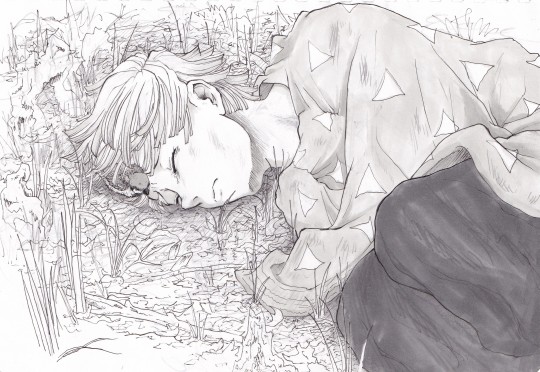
“Jii… chan…”
—
Chapter Seven Omake, “The Legend of Ukogi”
Full view recommended.
#self-reblog because I REMEMBERED THAT MOMENT IN THE NEW OP#it has me clutching my chest and holding back tears#Best bird is baaaaaaaack#in the saddest of ways but still#also I reread all the comments on this fic and I am so touched and grateful to everybody who gave a fic with this premise a try#thank you#delete later
329 notes
·
View notes
Text
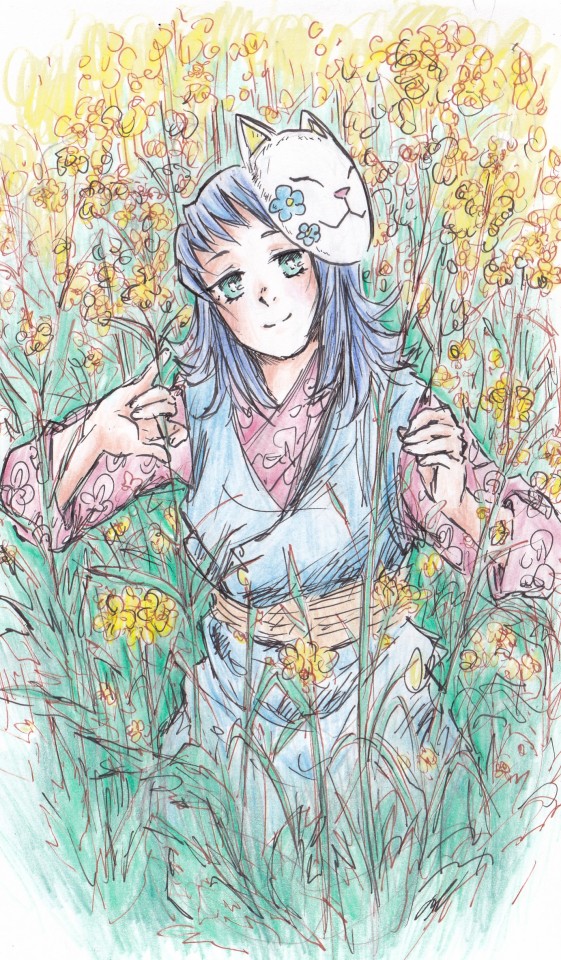
I found Makomo making another white crown that misty day, and I asked her if those white ones were her favorite flower. No, she laughed, and replied that those were the flowers in bloom. Ah, I responded, then her favorites must be those ones on her kimono, for Urokodaki-san had painted them on the fox mask.
She looked surprised a moment, then said maybe he never knew her favorite flower. I had to ask her what her favorite was, and she told me she loved nanohana, how the they fill the springtime with seas and waves of yellow over wispy green forests. She especially loved to see them in the height of daylight, with color so cheerful that demons could never come within hours of glimpsing it.
"They don't grow on Mt. Sagiri," she finished, "I wish I could see them again."
----
One of my Fanbook #1 details is Makomo's favorite flower. There's nothing quite like a field of bright tall nanohana; it's a captivating even if they are a relatively common wildflower.
208 notes
·
View notes
Text

Sketch version, off she goes
Colored version here
49 notes
·
View notes
Photo

On my way
113 notes
·
View notes
Text

Wind down doodle, and hell yeah, it goes with the Makomo Stayed Calm A Little Longer AU because I love that one
#my art#makomo#kny fix it au#there was a Makomo cosplayer at the con I went to last month and she totally looked the part and it made me so happy
110 notes
·
View notes
Text
Nerdy cultural details about the Hashira
Some details can be hard to pick up without context or in translation. Here's a handful for fun:
Breath names:
The "Mushi" (蟲) of "Mushibashira" (蟲柱) does not necessarily mean "insect." It's also not the more commonly used "mushi" kanji (虫). Kanji is often formed with many components compounding together to make new meanings, and 蟲 is a crowd of three 虫. While it might be tempting to simply say that this is a whole bunch of 虫, I've also heard this described as 蟲 being the more abstract idea of the concrete 虫, or that 蟲 went through a resurgence in popularity shortly before the Taisho Period. 虫 is preferred nowadays for its simplicity.
In either case, it's not necessarily "insects." Rather than being limited to six-legged creatures, "mushi" is a catch-all term for many kinds of creepy-crawlies that simply do not fit in other categories of animals, so spiders and centipedes and worms are all part of it. Actually, the term was originally used for snakes!
Next, what are picturing when you hear "Stone Hashira"? Something in your hands that you can throw? A big stone to lay on for warmth after training in a waterfall?
You could think even bigger than that, because the "stone" kanji used is "iwa" 岩. This is usually something at least as big as the boulders Himejima pushes around to train with, but it could just as well be a whole cliff.
So then how about that issue raised about how you can never refer to "Flame Breath" as "Fire Breath"? This might be a review since it gets brought up a lot, but it's worth restating because it makes a lot of sense in context.
First, we have two kanji to work with: 炎 for flames, and 火 for fire. To make a long linguistic history short, Japan adopted written pictographic characters from China, smashed and smooshed them around to fit the spoken Japanese language, and eventually many kanji wound up with multiple pronunciations. Case in point, 炎 is "hono'o" in the context of Flame Breathing (Hono'o no Kokyuu), and "en" in the context of "Flame Hashira" (En-bashira).
火 likewise has multiple pronunciations, but a common one is "hi." Another simple kanji that can be read "hi" is 日, the sun.
Therefore, even if they are written differently, "Sun Breathing" and "Fire Breathing" would sound the same, as "Hi no Kokyuu." This also makes it easy for "Hinokami" to be construed as "Fire God" instead of "Sun God." But why stop there, really? If you want to get into older Japanese, sometimes phonetic "hi" was used in simple reference to the power of gods.
Symbolism:
This is still somewhat linguistic rather than symbolic, but you know how Sound Breath is derived from Thunder Breath?
It's worth pointing out that "Kaminari" (雷) in "Kaminari no Kokyuu" is in reference to the sound, as opposed to something like "Ikazuchi no Kokyuu" for "Lightning Breath" in reference to the sight. We can get really, really nerdy about Japanese words for thunder and lightning and how they relate to Kimetsu no Yaiba, so I already did that here.
What's more interesting to me in regard to Sound Breath is that it takes the "sound" concept of thunder and pushes it--this time with a bit of a firework motif, again in a way that would stress the sound instead of the dazzling light. Both Uzui and Zenitsu have exceptional hearing and are exceptional users of their Breath techniques, so this is either curious that a discerning sense of hearing might help, or ironic that they use such loud styles with their sensitive ears.
Moving on to snakes! There's really no shortage of serpent symbolism, so we'll just focus on a handful of examples. I have already written extensively about the positive associations snakes have with riches, especially white snakes. This is ironic, given Iguro's distasteful paste driven by riches.
Some of the other positive associations with snakes are that they are a water element animal on the geomancy system borrowed from China. Makes sense that this Breath would be derived from Water Breathing! There are many shrines dedicated to snakes and their gifts of rain and clean water, however, water can also be dangerous. A common interpretation of a major legend about an eight-headed giant serpent, the Yamata-no-Orochi, is that it symbolizes the destructive power of a flooded river. But hey, at least snakes are often equated to dragons for having the same water association, so that's pretty cool.
Setting aside the water association, the serpent itself can likewise be considered in negative lights. In the centuries leading up to the Taisho Period, it became commonplace in Buddhist teachings and entertainment to compare jealous women to snakes. This association with woman also adds another layer of cruel irony to Iguro's past.
On a happier note, let's move on to cherry blossoms!
Well, not always happy, seeing as they are known to scatter tragically soon (I am shaking my fist at you, Gotouge). Cherry blossoms are also heavy with all the directions you can go in with symbolism, and I don't have any particular take on why they are part of the overall motif of the Love Hashira (see here for a little commentary on why it is "Koi" 恋 and not "Ai" 愛).
However! I do want to point out something very clever Gotouge did!
You know how Mitsuri's hand guard looks like four hearts that all meet at their pointy ends? This is actually a traditional cherry blossom motif!! Not a very common one, which is why I find it so sly.
Personal Names:
Bear with me, this section will get slightly more speculative, as names are always up to interpretation. I should know, I've done a lot of that for this series.
Remember how kanji can be read in multiple ways? Here's something simple you'd see right away in Japanese but that gets lost in translation to most other languages. Both Sanemi and Genya have 弥 as the second character in their personal name (as "mi" or "ya"). This was not the case for all their siblings, but it's cute that the two of them share it anyway.
So what does it mean? In modern kanji dictionaries, it's pretty bland: "increasingly." However, this kanji has more interesting use and associations that that. It was originally 彌, which carries more of an image of a stretched bow, or how something might go wide and disperse. As a child's name, this might include some hope that they might grow big and tall and go to great places. It is also commonly used in expressing the names of Buddhist deities in Japanese, but it is used only for the "mi" sound instead of the meaning in these cases. (Still, 弥 is one of the "Namu Amida Butsu" characters all over Himejima's haori, which also adds a little cuteness to his associations with Genya.)
So how about someone else with a name that closely matches his brother's? We get a pretty good explanation of Yuichiro (有一郎) and Muichiro (無一郎), with 有 and 無 being opposites (to exist/to not exist). While 有 might be more straightforward in wishing for Yuichiro to have all his needs met, the "mu" in "muichiro" is for "limitless/infinity/etc, etc."
But also!!
It bares distinct resemblance to a common Zen phrase, "Honraimuichimotsu" (本来無一物), with "muichimotsu" meaning "nothing exists" (and therefore, you have nothing to worry about, just be happy).
Speaking of resemblances, "Tomioka Giyuu" has two kanji in common with the name of the mangaka of Hunter x Hunter and I sometimes wonder if he was named in homage. But that is neither here nor there, and I'll just finish today by focusing on "Giyuu" (義勇).
This is pretty basic and straightforward: "loyalty/justice" and "bravery/courage." Pretty lofty. Put them back together and it's basically a set term for "heroism."
However, put it together with other terms for squads or armies, and this is the now the word for "volunteer soldier" or "volunteer army." Historically, it would continue to be used a few decades after Kimetsu no Yaiba takes place, but the decades prior, there were "Giyuutai" organized volunteer troops as well. Perhaps Giyuu had ancestors who fought as volunteer soldiers? Who knows.
102 notes
·
View notes
Text
This joke of a post meant I had to see what a personality transplant would look like:

As I was doodling in jet-lagged stupor I thought, "wait, I see the resemblance!" and had to try out one more:

#good night#my dumb art#tokitou muichirou#tokito muichiro#rengoku kyojuro#rengoku kyoujurou#rengoku ruka
118 notes
·
View notes
Text
One last Pillar Puppet shenanigan with siblings before my flight tomorrow. Muichiro was looking a little brain dead...

...so we did a brain transplant.

So that was all well and good and then I turned my back for one moment and changes had been made.



68 notes
·
View notes
Text
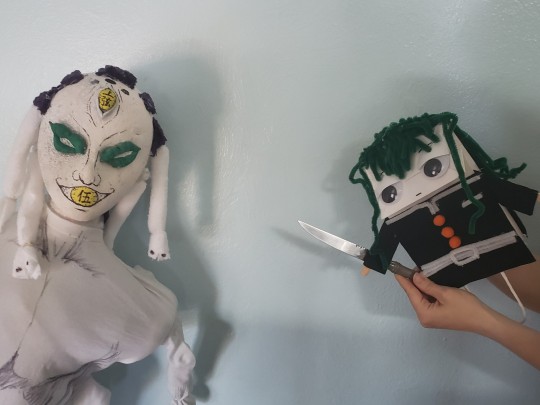
"Your vase looks crappy."
"Your face looks crappy!!"





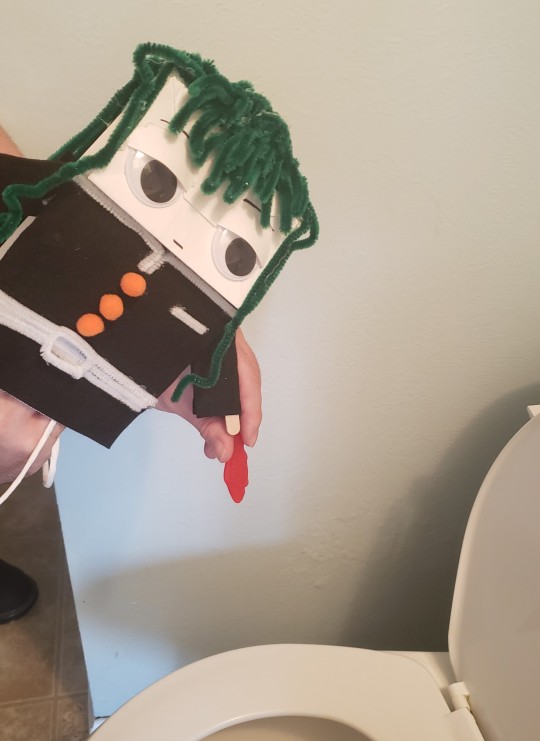

#thank you all for your ideas#goodbye Mr. Gyokko#gyokko#tokito muichiro#tokitou muichirou#kny silliness
125 notes
·
View notes
Text




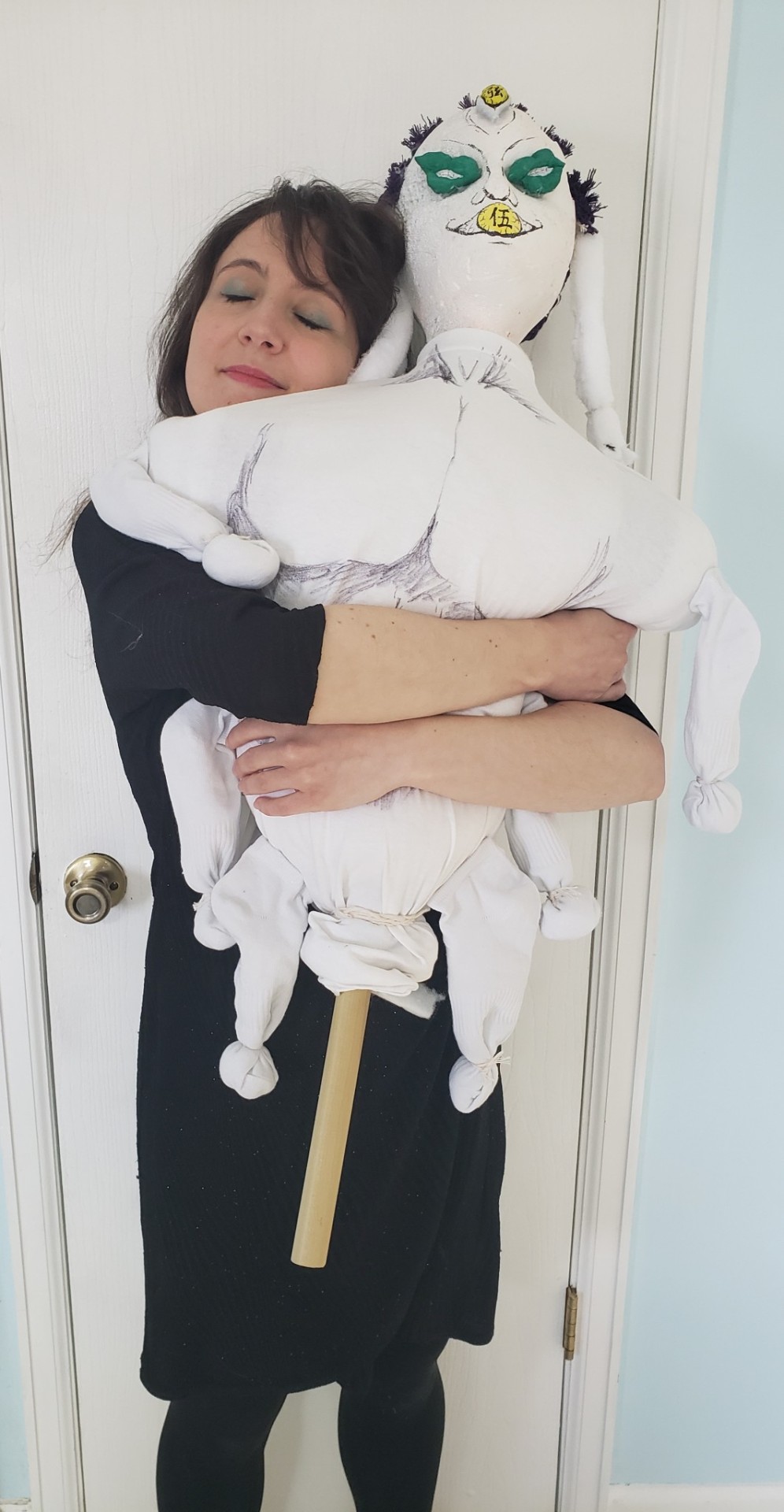
Goodbye, Mr. Gyokko. You were cuddly.
Ask Box is very temporarily open to collect ideas for demolishing Mr. Gyokko.
Naturally, our first idea was to take him into the sun and light him on fire, but there are a lot of good reasons for why this is not a good idea. We are playing with thinking of ways to make it fun for children (potentially very young children) to attack him, but nothing specific yet, and it would need to be safe and not that messy.
Unrealistic, funny ideas accepted as well.
80 notes
·
View notes
Note
Piñata Gyokko? I might not be the only one with this idea xD that or use it on a campfire to roast marshmallows... (or fish shaped marshmallows. That would be ironic). By the way. I loooove your blog! Your analysis and all the hard work you put in your research for the series is so inspiring, interesting and useful, and I love every single post of yours. Thank you thank you thank you! You're a gem in this fandom. <3
There were not marshmallows, but there were indeed fish involved. My brother did make many attempts to light them on fire but they didn't catch.
And thank you!! Not all posts are equally inspired, but I have had many fun hours spent across the blog!
5 notes
·
View notes
Note
HI HI HELLO. OK, SO WHAT I'M ABOUT TO ASK ISN'T ABOUT THE DOWNFALL OF GYOKKO. BUT. HERE ME OUT???
So at the end of season 1 of Demon Slayer Tanjiro's Kasugi Crow comes and tells them about their mission with Rengoku on the Mugen Train. But where are they? The background doesn't look like the Butterfly Estate at all so are they at a Wisteria House?? I don't know 😭 as a fanfic writer I'm clawing off my skin.
Also for your Gyokko dilemma, I think hanging him from a tree and letting small children beat him like a pinata is an excellent idea.
THANK YOU FOR READING THIS. PLEASE HAVE A GOOD DAY!!
I HAVE INDEED PUZZLED OVER THIS BEFORE and my conclusion is that the Butterfly Mansion has regular Japanese style guest rooms (as matches other scenes in the Japanese style mansion) where residents who don’t require medical care can stay. Gotta keep those hospital beds open!
As for Mr. Gyokko, we did use him like a pinata but hanging him from a tree would have been a fire hazard in daylight.
9 notes
·
View notes